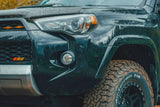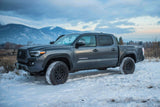Lifting your truck gives it a bold, aggressive look, and with the added ground clearance, it’s ready for any trail or backroad adventure. But whether you’ve added a basic leveling kit or a full suspension lift with oversized tires, there’s one important consideration that can’t be ignored: staying street legal.
Vehicle modification laws vary dramatically across the United States. What’s completely legal in Texas might get you pulled over in California. In this blog, we’ll walk through what it takes to keep your lifted truck street legal, common regulations to watch for, and how to check the rules in your specific state.
Why Street-Legal Compliance Matters
Aside from avoiding fines or having your vehicle impounded, staying within your state’s legal guidelines ensures:
-
Safety for both you and others on the road.
-
Insurability, as many insurance companies require modifications to meet state code.
-
Inspection approvals, especially in states that require annual vehicle inspections or emissions testing.
Common Regulations for Lifted Trucks
Though laws vary, most states regulate lifted trucks based on one or more of the following categories:
1. Maximum Bumper Height
Some states set a limit for how high your front and rear bumpers can be from the ground. This limit often varies depending on the vehicle’s gross vehicle weight rating (GVWR).
Example:
-
-
Ohio: Front and rear bumper height limit is 24 inches for vehicles under 4,500 lbs GVWR, and up to 31 inches for vehicles between 7,500–10,000 lbs.
-
2. Headlight and Taillight Height
Lighting must remain within a specific vertical range to ensure proper visibility and avoid blinding other drivers.
Example:
-
-
California: Headlights must be between 22–54 inches from the ground.
-
3. Fender Coverage & Tire Tread
Many states require tires to be fully covered by fenders or fender flares to prevent debris from being thrown off the road. This is especially important for lifted trucks with wide offset wheels.
Example:
-
-
Colorado: Tires cannot extend more than 1 inch beyond the fender unless covered by flares.
-
4. Frame Height
In some states, there are strict rules on how high the vehicle’s frame can be above the ground. This differs from bumper height and may restrict the use of certain body lifts.
5. Suspension Modifications
While most states allow suspension lifts, they may regulate the total lift height or ban certain components (like stacked blocks or shackle lifts in the rear).
6. Emissions Equipment
Your lift should not interfere with required emissions systems. In states like California, any modification that alters emissions equipment can result in your truck failing inspection, even if it runs clean.
Examples of State-Specific Lift Laws
Here’s a quick overview of how lift laws differ across a few states:
| State | Bumper/Frame Height Limit | Other Key Notes |
| California | 27"–30" bumper max (varies by GVWR) | Strict emissions rules; fender coverage required |
| Texas | No height restriction | Must pass state inspection and headlights must be at legal height |
| New York | Frame height max: 27" | Fender coverage enforced; no tires sticking out |
| Florida | Bumper height based on GVWR | 24"–28" range; wide tires require flares |
| Michigan | Frame height max: 29" | Tires must be covered; lighting height enforced |
How to Check Your State’s Lift Laws
To find current regulations for your state:
-
Visit your state’s DMV or DOT website
-
Search terms like “lift kit laws,” “suspension height limits,” or “vehicle modification regulations”
-
Contact a local inspection station or certified mechanic for advice
-
Check with your insurance provider to see if they have additional requirements
Tips to Stay Compliant
-
Measure everything — Know your current bumper, frame, and light heights before making further modifications.
-
Install fender flares — Especially if running oversized tires with negative offset.
-
Use legal lighting — Avoid aftermarket lights that exceed brightness limits or are mounted too high.
-
Avoid illegal lifts — Stay away from stacked blocks, homemade spacers, or untested suspension components.
-
Keep receipts and certifications — Having documentation helps prove your lift is professionally installed and DOT-compliant.
Final Thoughts
Lifting your truck doesn’t mean you have to sacrifice legality. With the right parts, smart planning, and a little research, your build can be both off-road capable and street legal, no matter what state you’re in.
At Reaper Offroad Lifts, we design our products with compliance and quality in mind. Whether you're running a 1.5” rear block or going for a full leaf spring setup, our components are made to perform safely on and off the pavement.
Want help choosing a lift that’s legal in your state? Contact Us or browse our collection of compliant lift kits today.





0 comments